What is NAM
Native American myopathy (NAM) is a putative autosomal recessive disorder that affects growth and development of limbs with symptoms including cleft palate, ptosis, short stature, congenital weakness, arthrogryposis, kyphoscoliosis, and talipes deformities. Patients with NAM may also have increased susceptibility to malignant hyperthermia that is triggered by anesthetics during surgical procedures.
NAM was first discovered and reported among American Indian descendants of Lumbee tribe in North Carolina, but has since been diagnosed in African, Middle Eastern, and South American descendants outside the U.S.
STAC3 was identified through a genetic screening in zebrafish as a component of muscle excitation-contraction coupling process, and subsequently mapped to the region of the human genome associated with the defects observed in NAM. Touch triggered swimming in wild-type control but not STAC3 mutant zebrafish embryos.
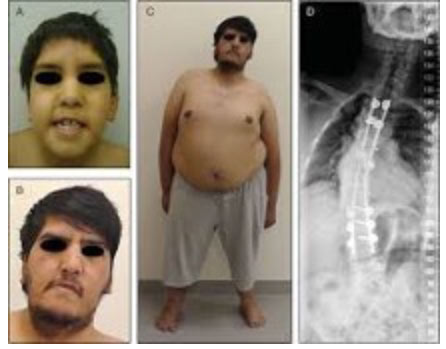
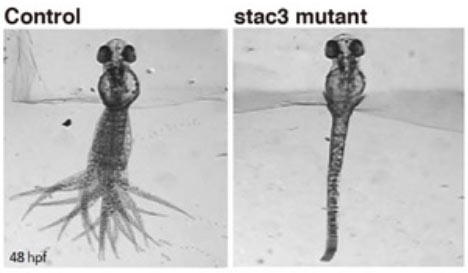
Natural History
Newborn & Toddler
- Mortality often due to pulmonary hypoplasia and pneumonia
- Myopathic face with ptosis and open, down-turned mouth, macrocephalic with enlarged ventricles
- Eating difficulties attributable to oral hypotonia, cleft palate, and micrognathia, leading to poor weight gain
- Delayed motor development resulting from muscle weakness
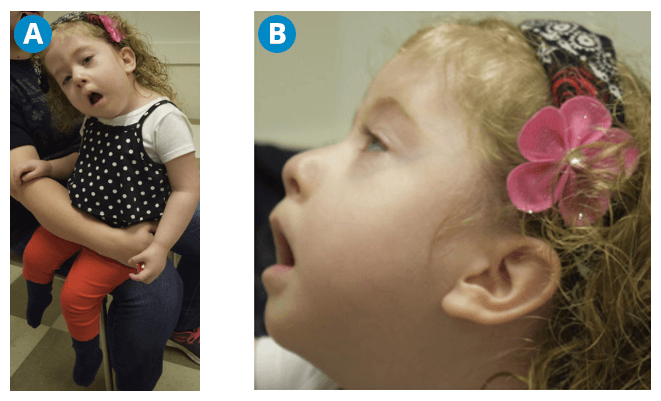
A) Myopathic facies (ptosis, tented mouth), hypotonia, & club feet
B) Micrognathia & low-set ears
Childhood
- Often reach normal intelligence
May experience language delays and hypernasal speech due to cleft palate, residual palatal fistulae, and oral hypotonia poor weight gain - Delayed motor development resulting from muscle weakness
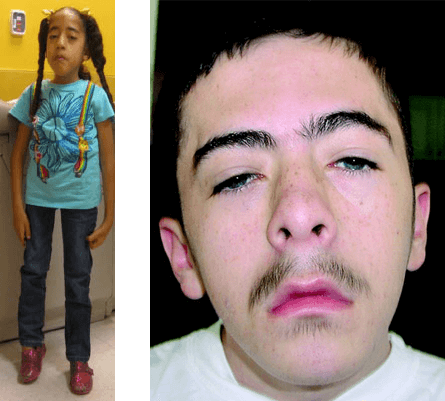
Myopathic facies & short stature
Adulthood
- Short stature
- Cachexia with significant muscle wasting
Often develop a long, narrow face and prominent chin, poor weight gain - Delayed motor development resulting from muscle weakness
Photos: American Journal of Medical Genetics. 2008 Jun 13.
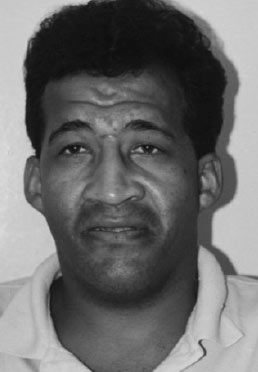
30 yr. old; long face & prominent mandible
Chronicles of NAM Discovery
| Year | Findings | PubMed Link |
|---|---|---|
| 1987 | Bailey and Bloch reported a case of an American Indian baby presenting with cleft palate, micrognathia, talipes equinus, arthrogryposis, and malignant hyperthermia. | https://pubmed.ncbi.nlm.nih.gov/3631569/ |
| 1988 | Stewart et al reported shared symptoms of congenital myopathy, skeletal anomalies, and susceptibility to malignant hyperthermia in 6 Lumbee children, suggesting autosomal recessive inheritance. | https://pubmed.ncbi.nlm.nih.gov/3245876/ |
| 2008 | Powell et al. systematically investigated the complex clinical features and natural history of 14 NAM patients of Lumbee descent, as well as estimated NAM prevalence and mortality rate. | https://pubmed.ncbi.nlm.nih.gov/18553514/ |
| 2013 | Horstick et al identified a homozygous p.Trp284Ser variant in human STAC3 gene, present among affected individuals of 5 Lumbee families, as the genetic basis of NAM. | https://pubmed.ncbi.nlm.nih.gov/23736855/ |
| 2015 | Beam et al elucidated that STAC3 is an essential chaperone in the trafficking of CaV1.1, a principle subunit of DHRP, by mediating excitation-contraction in skeletal muscle. | https://pubmed.ncbi.nlm.nih.gov/25548159/ |
| 2017 | Hoover-Fong et al identified STAC3 pathogenic variants in 2 non-Native American families, with overlapping features of Carey-Fineman-Ziter syndrome and Moebius syndrome. | https://pubmed.ncbi.nlm.nih.gov/28777491/ |
| 2018 | Zaharieva et al reported 18 patients, mostly of African, Middle Eastern, and South American descent, who carried STAC3 pathogenic variants and demonstrated impairment in excitation-contraction coupling. Genetic screening was recommended for any ethnicity presenting with congenital myopathy. | https://pubmed.ncbi.nlm.nih.gov/30168660/ |
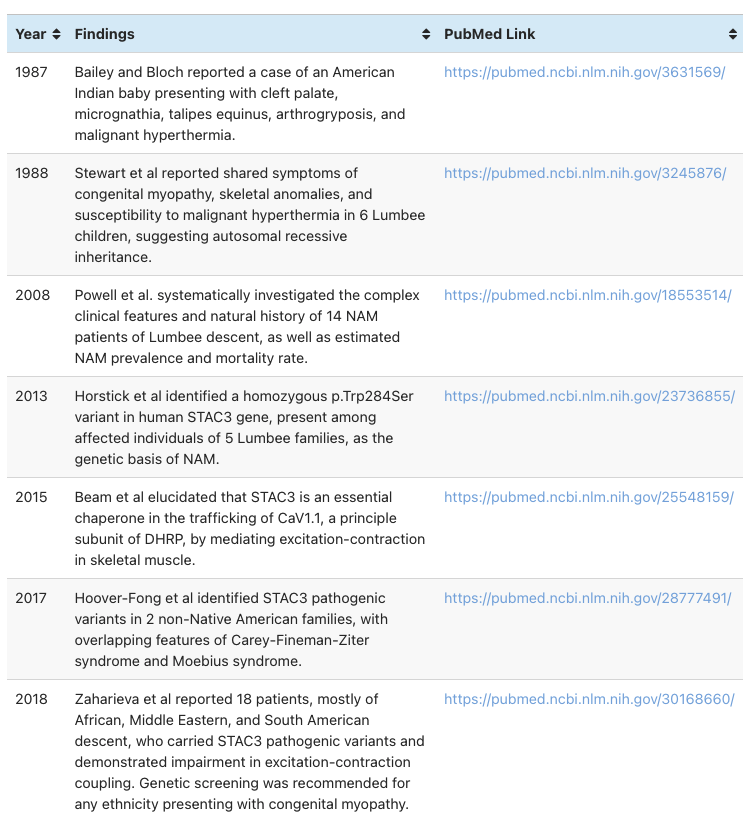
Epidemiology & Inheritance
All NAM pedigrees have demonstrated two unaffected parents of Lumbee descent having a child with NAM. There has been no evidence of X-linked or dominant inheritance. The pedigrees designate NAM as an autosomal recessive condition, in which unaffected parents that carry a single copy of the recessive NAM mutation have an affected child with both recessive copies.
The estimated minimum prevalence of NAM is approximately one in 5,000 within the Lumbee population.
NAM has been identified in non-Native American families in the US, as well as patients outside US of African, Middle Eastern, and South American descent.
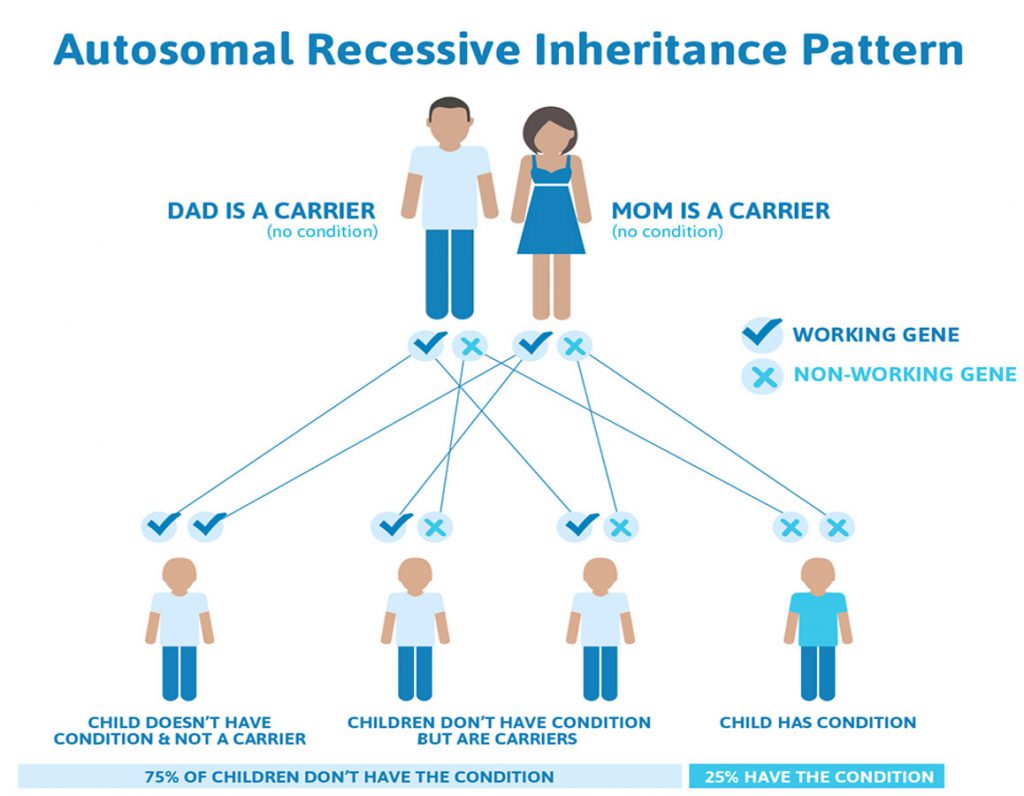
Lumbee Tribe of North Carolina
The Lumbee people are a Native American group originating from the Lumber River region in North Carolina. It is theorized that the tribe descended from Sir Walter Raleigh’s Lost Colony of Roanoke Island. The ancestry of Lumbee Native Americans is a mixture of Cheraw Indian, English, and African American. The Lumbee Tribe has a current population of more than 45,000 and is the largest tribe east of the Mississippi River. However, the Lumbees have been culturally isolated for the past two centuries, giving rise to frequent intra-tribe marriages.
The genetic basis of NAM is likely due to a founder effect, in which members of an isolated or inbred population can inherit a disease-causing mutation from a common ancestor. Offspring of related parents share a greater proportion of identical alleles than offspring of unrelated parents. These homozygous loci may ultimately result in genetic mutations responsible for recessive diseases.

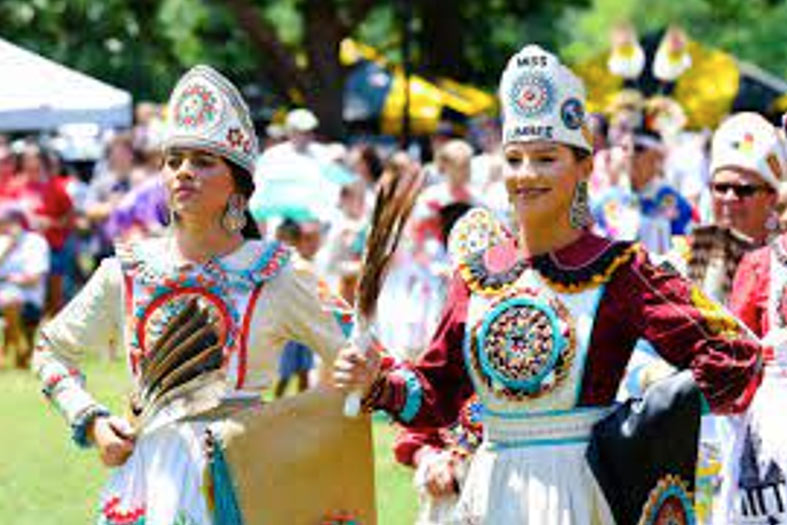

© 2021 STAC3.org